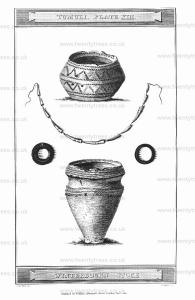Winterbourne Stoke West Barrows
Winterbourne Stoke West Barrows is in Station 5 Amesbury North.
Station V. Amesbury. North District.
Iter l. In my description of the last Station, Wily, I slightly noticed a group of barrows on the west side of the valley leading from Shrewton to Winterbourn Stoke. They are situated at a short distance from the latter village, on a gentle eminence, and are twelve in number; nine of them are surrounded by a ditch and vallum, enclosing an area of about four acres, bat certainly of a period subsequent to the barrows within it. All these tumuli, excepting one, were investigated in the month of July 1809, and the following is the result of our researches.
No. 1 [Map] is a large and wide Druid barrow, in which it appeared that the primary interment had been moved to make room for the subsequent deposit of a skeleton, which also had been disturbed at some still later period. In examining the cist which contained the skeleton, we observed that the feet had not been displaced; near them was an iron knife; and in our further researches we found at the bottom of the cist several fragments of burned bones, belonging to the remains of the original interment.
No. 2 [Map], like many of the others in this group, is much mutilated, and of large diameter, but not more four feet in elevation. It contained an interment of burned bones secured within a very large brown urn rudely ornamented, which was broken by taking out. A considerable quantity of linen cloth was perceptible among the bones.
No. 5 [Map], a circular flat barrow, contained a double cist; the smallest of which produced a little dagger of brass, and a variety of beads, amongst which were two joints of the vertebral column of a petrified encrinus. The beads, in number about four dozen, were neatly made of clay, but not well burned, except two of the largest, which had been ornamented with faint striæ. Besides the above were a great quantity of curious little shells, in shape like the Hirlas horn used by the Britons, which were perforated lengthways, and formed probably the necklace of some female. (Tumuli Plate XIII.) The large cist contained only the bones of a sheep.

No. 8 [Map], a very irregular flat barrow, three feet high, produced near the centre a large urn standing upright within a circular cist, and containing, amongst an interment of burned bones, a small brass dagger, with a bone top to it, neatly finished, with five holes on the side for so many rivets, by which it was fastened a wooden handle. The urn found in this tumulus was very large, and elegantly formed; (Tumuli Plate XIII.) it contained a few black beads that had undergone the action of fire, and was so closely cemented to the chalk, that we had great difficulty in detaching it from the cist.

No. 9 [Map], a flat circular barrow, contained two small round cists, in each of which was deposited an interment of burncd bones; in one we found curious little double cup;1 in the other, no articles whatever.
Note 1. This cup has a division in the middle, which renders the hollow on each side equal it is unlike in this particular any we have yet found, and is very neatly ornamented in the usual rude style, with the Vandyke pattern. An engraving of it, full size, is given in Tumuli Plate XIII.

No. 10 [Map] was opened by Mr. Cunnington in the year 1804. In its form, it resembles the second class of Druid Barrows, is neatly ditched round, having the vallum without, and the tumulus rising gradually to its apex from the ditch. It contained an urn inverted over the burned bones, which had been wrapped up in a linen cloth, to protect them; and with the bones were found a small brass pin, employed probably for fastening the cloth, five rings of a dark brown colour, one of which was perforated for suspension, (Tumuli Plate XIII.) a small cone of the same materials perforated also for the same purpose, and several pully beads of glass, with one of jet, and another of amber.

No. 12 [Map]. The vallum of this large Druid barrow is so much defaced, and the elevation of the mound so very trifling, that it might easily escape general notice. It contained a very large rude urn, sixteen inches and a half deep, inverted over an interment of burned bones, and within it a smaller vase. With them were found two black rings similar to those before described, but not perforated for suspension, large amber bead perforated, four pully beads, and three of a black colour. The three last mentioned barrows are situated on the outside of the bank and ditch, which, at first sight, bear an equivocal appearance from their singular shape, resembling a pentagon, which I have before, stated as being a favourite form with the Britons; but on a close investigation of them, they appear decidedly of a more modern date than the barrows. The name of the hill, Conigar, and the vulgar tradition of this spot having once been appropriated to a rabbit-warren, will corroborate this conjecture, and ascertain the origin of this earthen enclosure. On the adjoining hill, called High Down, and to the N. W. of the group of barrows, are the decided remains of a British village, in which we found coins of the Lower Empire, pottery of various sorts, with animal bones, and all the usual indicia of an ancient British and Roman population.